Chandragupta Maurya › Chang'an › Plague of Cyprian, 250-270 CE » Origins and History
Articles and Definitions › Contents
- Chandragupta Maurya › Who Was
- Chang'an › Origins
- Plague of Cyprian, 250-270 CE › Origins
Ancient civilizations › Historical places, and their characters
Chandragupta Maurya › Who Was
Definition and Origins
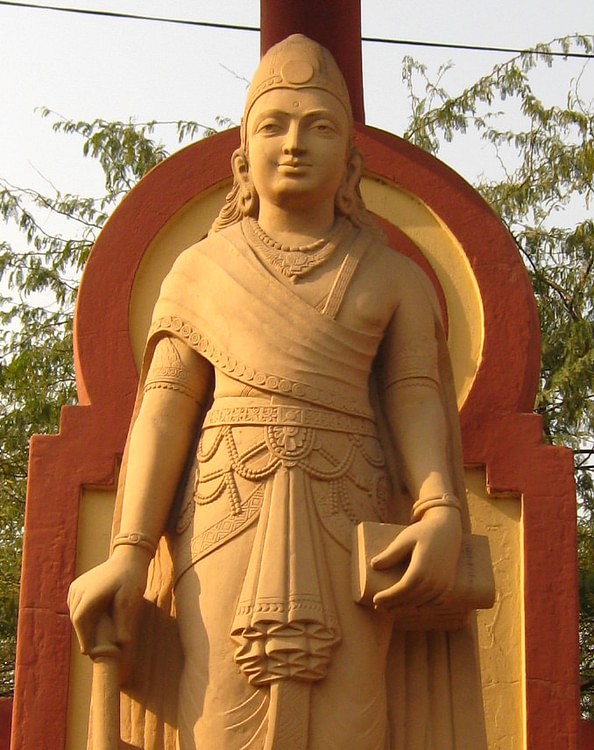
Indian Emperor Chandragupta Maurya lived from 340-298 BCE and was the first ruler of the Mauryan Empire. He ruled from 322-298 BCE; he was the father of Emperor Bindusara and grandfather of Emperor Ashoka, who was the third Mauryan ruler and under whose reign the Mauryan Empire reached its full power and became the largest empire ever in the Indian subcontinent and one of the world's largest empires at that time.
Before the time of Chandragupta, India was mostly composed of a number of small independent states, with the exception of the Magadha kingdom, a realm that controlled most of Northern India, which was ruled by the Nanda dynasty. Chandragupta began a process that would unify India for the first time in history.
THE LIBERATION OF INDIA
During 326 BCE, while fighting his way into India, Alexander the Great came across the army of King Porus, the ruler of the local state of Paurava, located in modern day Punjab. After fighting to his last breath, King Porus surrendered to Alexander, who was impressed by the courage and stature of his enemy. Alexander made Porus his ally and turned him into king of all conquered India as a Macedonian tributary. Shortly after this, Alexander's army refused to go any further into Asia; his men mutinied and thus the Macedonian army turned back and left India.
CHANDRAGUPTA'S COURAGE, COUPLED WITH KAUTILYA CHANAKYA ’S INTELLIGENCE, TURNED THE MAURYAN EMPIRE INTO ONE OF THE MOST POWERFUL GOVERNMENTS OF THE TIME.
Chandragupta was a noble member of the Kshatriya caste (the warrior-ruler caste) and the main proponent for removing all fragments of Macedonian influence form India. He was related to the Nanda family, but he was an exile. Ironically enough, Chandragupta was a fugitive in the camp of Alexander the Great during the time of his exile, and it is possible that he personally met Alexander the Great.
With the help of his wise chief advisor and future prime minister Kautilya Chanakya, Chandragupta raised a small army. The military strength lacked by Chandragupta's force was balanced out by the cunning strategies used by Kautilya Chanakya.Chandragupta entered the capital of the Magadha kingdom, Pataliputra, where he triggered a civil war using Kautilya Chanakya's intelligence network. In 322 BCE he finally seized the throne putting an end to the Nanda dynasty, and he established the Mauryan Dynasty which would rule India until 185 BCE. After this victory, Chandragupta fought and defeated Alexander's generals located in Gandhara, present day Afghanistan. Following these successful campaigns, Chandragupta was seen as a brave leader who defeated part of the Greek invaders and ended the corrupt Nanda government, thus gaining wide public support.
Chandragupta's courage, coupled with Kautilya Chanakya's intelligence, soon turned the Mauryan Empire into one of the most powerful governments at that time. Pataliputra remained the imperial capital, and the initial territory controlled by Chandragupta extended all across Northern India from the Indus River in the west to the Bay of Bengal in the East.
After the death of Alexander the Great in 323 BCE, the Eastern territories controlled by the Macedonians fell into the hands of General Seleucus, including the region of the Punjab, which today is part of Northern India and Eastern Pakistan. Seleucus was busy enough with what was happening on the western borders, so Chandragupta saw a tempting opportunity and launched an attack on Seleucus and captured a big portion of what today is Pakistan and Afghanistan. In 305 BCE, Chandragupta signed a treaty with Seleucus in which both rulers established borders, and the Punjab was given to Chandragupta in return for 500 war elephants.

Chandragupta Maurya's Empire
THE GOVERNMENT OF CHANDRAGUPTA & IMPERIAL EXPANSION
During the government of Chandragupta, we find the Greek Magasthenes, an ambassador of Seleucus, who lived in the court of Pataliputra from 317-312 BCE. He wrote many different reports about India and although his original work is lost, we can piece together some information found in subsequent works. He reported that the Indians:
[...] never drink wine except at sacrifice [...] The simplicity of their laws and their contracts is proved by the fact that they seldom go to law. They have no suits about pledges and deposits, nor do they require either seals or witnesses, but make their deposits and confide in each other.
(Durant, 441)
Magasthenes also reports that Pataliputra was nine miles in length and about two miles in width. Chandragupta's palace was full of luxuries and all type of ostentatious possessions. Inside his palace, Chandragupta paid the price of ascending to power through the use of violence: he lived in it for 24 years, almost as a recluse, with very limited public exposure, solely devoted to the growth of the empire. He managed to extend his empire westwards and became the master of all Northern India.According to the reports of Magasthenes, Chandragupta's army was composed of 600,000 foot soldiers, 30,000 horses, and 9,000 war elephants.
After becoming the master of all Northern India, Chandragupta began a campaign to conquer the southern half of the Indian subcontinent. Battle after battle, the Mauryan forces absorbed most of the independent Indian states until eventually, in 300 BCE, the borders of the Mauryan Empire extended southward into the Deccan Plateau. Chandragupta, however, failed to annex the small kingdom of Kalinga in present day Odisha in central-eastern India, on the Bay of Bengal. This pending conquest would be completed in 260 BCE by Emperor Ashoka.
ABDICATION & DEATH
In 298 BCE, Chandragupta voluntarily abdicated the throne in favour of his son Bindusara, who became the new Mauryan emperor. What we know after this point seems closer to legend than an actual historical account. It is said that Chandragupta turned into an ascetic and follower of Jainism. Jain tradition claims that Chandragupta migrated south and, consistent with the beliefs of Jainism, he starved himself to death inside a cave. This event supposedly took place in Sravana Belgola, a cityabout 150 kilometers away from Bangalore, which is one of the most important places of pilgrimage in Jainism.
Chang'an › Origins
Definition and Origins
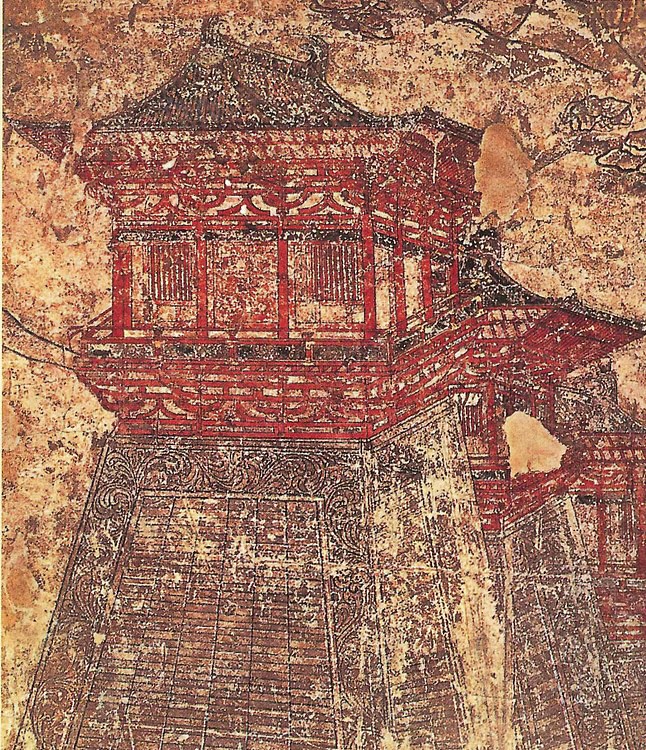
Chang'an, located near modern Xian in Shaanxi Province, was the capital of several dynasties of ancient China from the Zhou to the Tang and eventually became one of the world's great metropolises. With regular tree-lined avenues, high walls, pleasure parks, and areas dedicated to specific functions, it provided a model which was copied by other Asian capitals, notably in Japan and Korea.
EARLY SETTLEMENT & GEOGRAPHY
A settlement from Neolithic times, Chang'an was an ideal location for a capital as it was surrounded on all sides by mountains, providing a useful obstacle to invading armies, and was close to the Yellow and Wei Rivers. The advantages of the geographical location are described in the History of the Former Han Dynasty by Pan Ku,
In abundance of flowering plants and fruitsIt is the most fertile of the Nine ProvincesIn natural barriers for protection and defenceIt is the most impregnable refuge in heaven and earth(in Dawson, 59)
The name Chang'an translates as 'Forever Peace', and although not quite living up to its name, the city did remain important for well over a millennium. Chang'an was an important city in the Shang Dynasty (c. 1600-1046 BCE) but first became a capital under the Western Zhou (1046-771 BCE). When the Eastern Zhou dynasty (771-256 BCE) arose, the capital moved to Luoyang, Chang'an's great rival city which several times in Chinese history replaced it as capital.
THE HAN CAPITAL
After the turmoil of the Warring States period (481-221 BCE), Chang'an was capital again during the Western Han dynasty between 206 BCE and 9 CE. It has been suggested by ancient writers and some modern historians that the layout of the city was constructed to reflect exactly the corner points of the Great Bear constellation, but sceptics point to the evolutionary development of the city as an argument against this possibility. The city was given an armoury, a state-controlled market and a granary, projects supervised by Emperor Gaozu's chief minister Xiao He, who was subsequently rebuked for his excessive spending. The next emperor, Hui, saw the value to his reign of a capital that looked the part and ordered a new market, new walls, a mausoleum for Gaozu and an ice-house in the royal residence. The capital even had its own police force, headed by the superintendent of the capital, the Zhijinwu.
Emperor Wu, the fifth Han ruler, renovated two palaces and built three more. His most famous building project was the redevelopment of the Shanglin Park. Located to the south-west of the city, it had fallen into disrepair and Wu completely transformed it into a pleasure park with artificial water features, the Jianzhang Palace which became the royal residence, and many subsidiary structures. The park contained all manner of exotic flowers, tropical plants and trees and was given several statues including a whale and replica of the Milky Way. There was even a menagerie which included exotic birds, a rhinoceros, and an elephant.
IN THE EARLY PERIOD CHANG'AN WAS DOMINATED BY THE WEIYANG PALACE WHICH WAS BUILT ON CUT TERRACES ON THE DRAGON HEAD HILLS ABOVE THE CITY.
In this early period Chang'an was dominated by the Weiyang Palace which was built on cut terraces on the Dragon Head Hills above the city. The capital was next significantly developed by the early 1st-century CE Han regent and usurper Wang Mang.Mang built an imperial ceremonial hall ( piyong ), hall of light ( mingtang ) where the change in seasons was observed, and spirit terrace ( lingtai ) but even more celebrated were his nine temples ( jiu miao ), where the ancient kings of China were worshipped, the foundations of which still remain today. One such temple was a square structure with four doors set within a circular precinct with four gates. The city eventually reached an extent of around 450 hectares (c. 1110 acres). In addition, to the north of the River Wei, whole towns sprang up around the sites of the Qin and Han Royal tombs. The whole valley was becoming a major concentration of people.
THE SOUTHERN & NORTHERN DYNASTIES
After Luoyang had served as the capital of the Later/Eastern Han (23-220 CE), Chang'an returned as capital of many subsequent different dynastic states during the complex period of China's history known as the Southern and Northern Dynasties: the Jin (311-316 CE), the Zhao (319-329 CE), Qin (351-385 CE), Later Qin (386-417 CE), Western Wei (535-554 CE), and Northern Zhou (557-581 CE). The city was the capital of the Sui Dynasty (581-618 CE), which unified China once more, when it was redesigned by Emperor Wendi.
THE TANG CAPITAL
During the Tang Dynasty (618-907 CE) Chang'an was still the capital and became one of the great cities of the world and most important in East Asia. In the 8th century CE, at its peak, the city probably had the largest concentrated population on earth: close to 3 million inhabitants (one million inside the city walls and another 2 million in the surrounding suburbs. These people were drawn from all over China and included many immigrants, lured by the great commerce of the city, positioned as it was at the end of the Silk Road which crossed Asia. All manner of goods from furniture to spices were traded in the city's two great marketplaces.
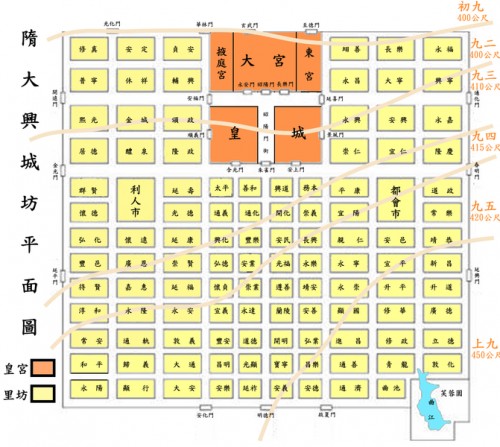
Chang'an Street Plan
The city now covered some 8,600 hectares (c. 21,250 acres) and was enclosed within 5.3-metre high walls made of packed earth which had gates on each side, the main one being the South Gate. Laid out on a rectangular grid pattern with 114 individually walled blocks, there were wide avenues and streets - 11 running from north to south and 14 from east to west - which were tree-lined and had ditches along their sides for drainage. There were canals, too, to better facilitate the movement of goods across the city and to link it to the areas of Peking in the north and the Yangtze Valley and Hangchow to the south.Certain areas of the city were dedicated to specific purposes such as manufacturing, commerce, and religion, as well as parks and private residential estates.
The tallest buildings would have been religious with Buddhist temples and pagodas dotting the city. For an idea of what these looked like it is today better to visit Japan than China where such temples as the Horyuji in Nara preserve the architectural plan and style of a typical Chinese temple of the 7th century CE. The temples of Chang'an, besides offering regular religious spectacles, relics for worship such as four of the Buddha ’s teeth, and artworks for the public's pleasure, also provided help to the poor, public baths and medicine and treatment for the sick. The government and palace buildings had their own walled compounds, and there were even areas for the use of visiting foreign embassies. Finally, in the south-east corner of the city was a huge pleasure garden with a lake, lotus ponds, flower gardens, and pavilions. There, people could enjoy the natural beauty, boat on the lake, and see festivals and shows put on by the emperor when colourful tents were set up for banquets and orchestras.
The city never stopped expanding or developing. In 634 CE Emperor Taizong established a new palace, the Great Luminous Palace ( Daming gong ) which was built in the great hunting park on the northern edge of the city. The palace, already grandiose, was further extended by Emperor Gaozong in 662 CE and included vast flower gardens and water features. The Hanlin Academy ( Hanlin yuan ) was founded in 725 CE by Emperor Xuanzong as a place of study for scholars, artists, writers, and astrologers. Meanwhile, the Pear Garden became a celebrated training school for actors, singers, and dancers.
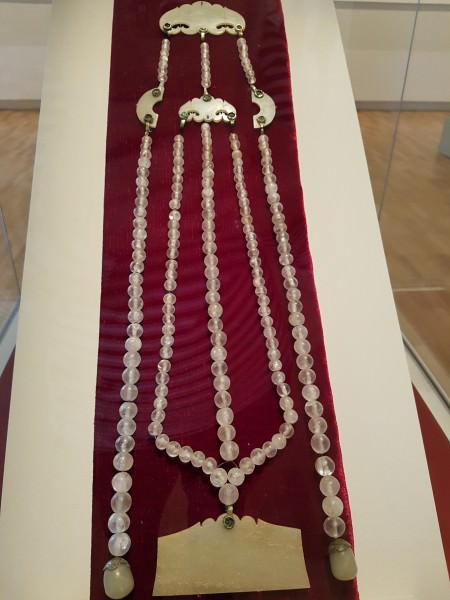
Jade & Crystal Ornament
DECLINE & LEGACY
Chang'an's glory days came to an abrupt end when it was sacked by Huang Chao in 880 CE who led a rebellion against the government which had already been weakened by years of warlords and bandits rampaging the countryside. Attacked again in 904-906 CE by the warlord Zhu Quanchong, Chang'an was replaced as capital by Luoyang once again. As much of the city's architecture was of wood, the more important buildings were dismantled and relocated while others were simply abandoned to decay. Eventually, the once great city became overgrown and the area was used for agriculture, just as it had been 2,000 years before. The city's ruin was eloquently described by the Tang poet Wei Chuang:
Desolate city of Changan, what do you now contain?Ruined bazaars, deserted streets where tender wheat-ears grow.Collecting fuel, they cut down every flower in Almond Park;For barricades they rooted out the willows of the Grand Canal.Gay-painted coaches, patterned wheels, have scattered long ago;Of splendid mansions, grand vermilion gates, not half remain!(Dawson, 61)
The city may have quickly disappeared physically but it did leave a tangible legacy in that Chang'an greatly influenced other capitals in East Asian states who were eager to be seen as civilised and advanced as China. Nara and it successor Heiankyo(Kyoto) in Japan and Gyeongju, the capital of the Silla kingdom in Korea, are prominent examples where the high walls, grid layout with wide avenues and segregated city districts of Chanag'an were imitated.
Plague of Cyprian, 250-270 CE › Origins
Ancient Civilizations
The Plague of Cyprian erupted in Ethiopia around Easter of 250 CE. It reached Rome in the following year eventually spreading to Greece and further east to Syria. The plague lasted nearly 20 years and, at its height, reportedly killed as many as 5,000 people per day in Rome. Contributing to the rapid spread of sickness and death was the constant warfareconfronting the empire due to a series of attacks on the frontiers: Germanic tribes invading Gaul and Parthians attacking Mesopotamia. Periods of drought, floods and famine exhausted the populations while the emperorship was rocked with turmoil. St. Cyprian (200-258 CE), bishop of Carthage, remarked that it appeared as if the world was at an end.

Relic of St. Cyprian
NAMING & INTERPRETATION
The outbreak was named after Cyprian as his first-hand observations of the illness largely form the basis for what the world would come to know about the crisis. He wrote about the incident in stark detail in his work De Mortalitate (“On Mortality”).Sufferers experienced bouts of diarrhoea, continuous vomiting, fever, deafness, blindness, paralysis of their legs and feet, swollen throats and blood filled their eyes (conjunctival bleeding) while staining their mouths. More often than not, death resulted. The source of the terrible affliction was interpreted by pagans as a punishment from the gods. This was not an unusual interpretation from a pre-Christian or early Christian culture throughout the Mediterranean world which understood disease to be supernatural in origin. Later scholars and historians sought alternative explanations.
THE SOURCE OF THE TERRIBLE AFFLICTION WAS INTERPRETED BY PAGANS AS A PUNISHMENT FROM THE GODS.
NATURE OF THE DISEASE
Identifying diseases from the ancient world is always difficult as the state of medicine and diagnosis lacked the degree of knowledge and sophistication available to modern science. Based upon the surviving accounts, the illness appeared to be highly contagious, transmitted both by direct and indirect contact (including through clothing). Throughout the centuries since the episode, scholars suggested a number of possibilities for the disease which ravaged the empire in the 3rd century CE: bubonic plague, typhus, cholera, smallpox, measles and anthrax. The lack of certain tell-tale symptoms eliminated many of these early suspects eg bubonic plague was eliminated as the contemporaneous accounts make no mention of swellings or buboes on the bodies of the afflicted. The variety of known symptoms suggested a combination of diseases including meningitis and acute bacillary dysentery. Kyle Harper, in his article “Pandemics and Passages to Late Antiquity,” argued that the most likely culprit was a viral hemorrhagic fever possibly Ebola.
A potential breakthrough in identifying the disease occurred in 2014 CE when Italian archaeologists unearthed bodies from the Funerary Complex of Harwa at Luxor (formerly Thebes ). It was discovered that attempts were made to stop the spread of the disease by covering the corpses with lime as well as burning the bodies. Attempts to extract DNA from the remains proved futile as the Egyptian climate causes the complete destruction of DNA. Without the DNA evidence, there may never be conclusive proof as to the actual disease(s) that ravaged Rome and the empire 1,800 years ago.
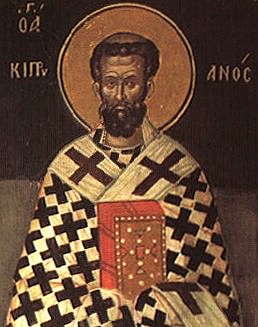
Icon of St. Cyprian
CONSEQUENCES
The disease episode of the mid-200s CE caused political, military, economic and religious upheaval. In addition to the thousands of people dying per day in Rome and the immediate vicinity, the outbreak claimed the lives of two emperors: Hostilian in 251 CE and Claudius II Gothicus in 270 CE. The period in between the emperors witnessed political instability as rivals struggled to claim and hold the throne. The lack of leadership and the depletion of soldiers from the ranks of the Romanlegions contributed to the deteriorating condition of the empire by weakening Rome's ability to fend off external attacks. The widespread onset of illness also caused populations in the countryside to flee to the cities. The abandonment of the fields along with the deaths of farmers who remained caused the collapse of agriculture production. In some areas, swamps re-emerged rendering those fields useless.
Only the nascent Christian church benefitted from the chaos. The illness claimed the lives of emperors and pagans who could offer no explanation for the cause of the plague or suggestions for how to prevent further illness much less actions for curing the sick and dying. Christians played an active role in caring for the ill as well as actively providing care in the burial of the dead. Those Christians who themselves perished from the illness claimed martyrdom while offering non-believers who would convert the possibility of rewards in the Christian afterlife. Ultimately this episode not only strengthened but helped to spread Christianity throughout the furthest reaches of the empire and Mediterranean world.
LICENSE
Article based on information obtained from these sources:with permission from the Website Ancient History Encyclopedia
Content is available under License Creative Commons: Attribution-NonCommercial-ShareAlike 3.0 Unported. CC-BY-NC-SA License